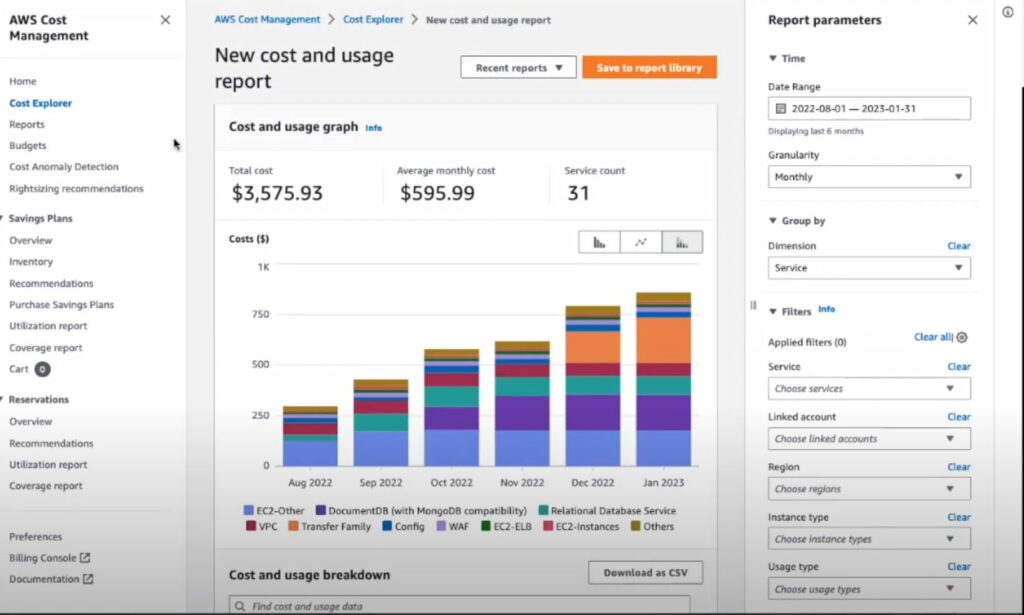
AWS Cost Components and Database Services
AWS Cost Components and Database Services – An AWS Web Talk with Todd Bernson
Hi, I’m Todd Bernson – CTO at Blue Sentry Cloud and an AWS Ambassador with 12 AWS certifications.
Amazon Web Services or AWS is a popular cloud computing platform that offers a wide variety of services to businesses of all sizes.
With the growing popularity of cloud computing, more and more organizations are leveraging AWS to reduce costs and increase efficiency.
However, the enormous amount of services offered in the platform can make it challenging to understand the different cost components and billing metrics associated with AWS.
This video will explore the various AWS cost components and billing metrics and how they can impact your AWS bill.
AWS Cost Components
To understand the different AWS cost components it is essential to know that AWS bills you for two main things: the use of AWS services and the resources that support those services.
The following are the main cost components with AWS:
- Compute services include things like Amazon Elastic Compute Cloud or EC2
- Amazon Elastic Container Service or ECS
- Amazon Lambda serverless compute
These services are used to run and manage applications and workloads.
The cost of compute Services is based on the type and number of instances you use and the amount of data you store and transfer.
Storage Services include Amazon Simple Storage Service or S3, Amazon Elastic Block Store (EBS), and Amazon Glacier among many others.
These services are used to store and manage your data. The cost of storage Services is based on the amount of data you store and transfer and your storage type.
Database Services
One of the best offerings, Database Services, includes many different types of offerings but some of the most popular are Amazon relational database service, Amazon Dynamo DB (their no SQL offering), and Amazon Redshift.
These services are used to manage and store data in a structured or unstructured manner.
The cost of database Services is based on the type of database you use, the amount of data you store, and the number of read-and-write requests
Network Services include Amazon Virtual Private Cloud, Amazon Direct Connect, and Amazon Route 53.
These services are used to connect and manage your network resources between on-prem and the cloud.
The cost of networking Services is based on the type and number of network resources that you use and the amount of data you transfer.
Management Services include Amazon Cloudwatch, Amazon Cloud Formation, and AWS IAM.
These services are used to manage and monitor your AWS resources while at the same time helping to secure it.
The cost of Management Services is based on the number of resources you manage and the number of requests you make.
Billing Metrics & AWS Billing
In addition to the cost components it is essential to understand the different billing metrics used to calculate your AWS bill.
The following are some of the most common billing metrics associated with AWS:
- Instance hours are the number of hours that an instance runs.
- The cost of an instance is calculated based on the number of hours it runs and the type of instance that you’re using.
- Data transfer is the amount of data transferred in and out of AWS.
- The cost of data transfer is based on the amount of data you transfer and the type of transfer, such as into AWS or out of AWS.
Requests
This is the number of requests you’re making to AWS Services. The cost of requests is based on the type of request you make and the service that you’re using.
Storage
This is the amount of data you’re storing in AWS. The storage cost is based on the amount of data you store and your storage type, where you’re storing it.
Understanding AWS cost components and billing metrics is crucial to effectively managing your AWS build.
Knowing the different cost components and billing metrics allows you to make informed decisions about your services and resources and minimize unnecessary costs.
It is also essential to monitor your AWS build regularly as the cost of AWS Services can change over time including, in my experience, going down.
AWS provides tools such as AWS Cost Explorer and the AWS billing and cost Management console to help you Monitor and manage your AWS costs. Let’s look at that now.

AWS Cost Explorer
Here you can see inside of cost Explorer one of the easy reports that AWS gives to us.
We can see here the growth of the different Services as this company has gone from development into production.
We can see each of these things broken down month by month and we can get very granular with this.
We can set up alarms on this, we can set up more granularity for each of these Services, and we can set up cost optimization by tagging.
But what we can definitely do is see that there is an enormous amount of control given to us over our cost and our spend inside of the cloud inside of AWS.
By utilizing these tools and being mindful of the AWS cost components and billing metrics you can ensure that your AWS Bill remains under control.
Contact Blue Sentry Cloud for Cloud Strategy Services
Blue Sentry Cloud is the country’s most densely certified Cloud firm and we would like to serve you.
